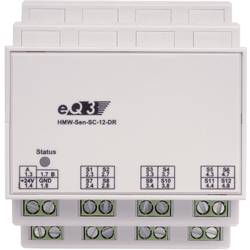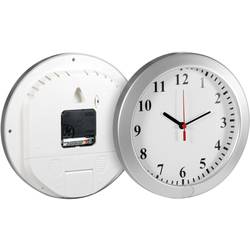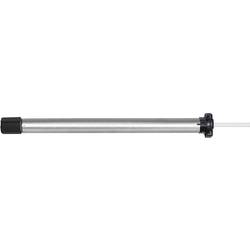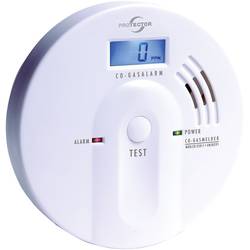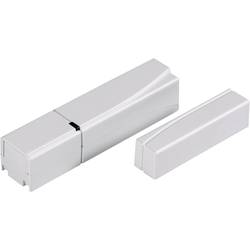€69.11
Priemerné hodnotenie:0/5(0x)
Vlastnosti a parametre výrobku
Skúsenosti užívateľov
Otázky a odpovede
Dokumentácia
Popis
Vlastnosti a parametre výrobku
| Séria (domáca technika) | Homematic |
|---|---|
| Cloudová integrácia (Smart Home) | Conrad Connect (CONRAD-CONNECT_SY_01) |
| Bezdrôtové zariadenie (Smart Home) | Hersteller-Spezifisch |
| Napájanie | 230 V |
| Prevádzkové napätie | 24 V/DC |
| Kanálov | 12 |
| Spôsob montáže | Klobúčikové tienidlo |
| Vonkajšia šírka | 72 mm |
| Vonkajšia výška | 87 mm |
| Rozmer, hĺbka | 64 mm |
Skúsenosti a názory zákazníkov
- Skúsenosti užívateľov nie sú k dispozícii.
Otázky užívateľov
- Užívatelia k tomuto výrobku zatiaľ nemali žiadne otázky.
Dokumentácia
Podmienky používania dokumentácie
Installations- und Bedienungsanleitung (S. 2) Installation and Operating Manual (p. 20) RS485 Schließerkontakt 12 Eingänge Hutschienmontage: RS485 12-channel shutter contact for mounting on DIN rails: HMW-Sen-SC-12-DR
2
1. Ausgabe Deutsch 03/2009
Dokumentation © 2009 eQ-3 Ltd., Hong Kong Alle Rechte vorbehalten. Ohne schriftliche Zustimmung des Herausgebers darf dieses Handbuch auch nicht auszugsweise in irgendeiner Form reproduziert werden oder unter Verwendung elektronischer, mechanischer oder chemischer Verfahren vervielfältigt oder verarbeitet werden.
Es ist möglich, dass das vorliegende Handbuch noch drucktechnische Mängel oder Druckfehler aufweist. Die Angaben in diesem Handbuch werden jedoch regelmäßig überprüft und Korrekturen in der nächsten Ausgabe vorgenommen. Für Fehler technischer oder drucktechnischer Art und ihre Folgen übernehmen wir keine Haftung.
Alle Warenzeichen und Schutzrechte werden anerkannt.
Printed in Hong Kong Änderungen im Sinne des technischen Fortschritts können ohne Vorankündigung vorgenommen werden.
84666 / V 1.00
3
Inhaltsverzeichnis 1 Hinweise zu dieser Anleitung …4
2 Gefahrenhinweise …4
3 Funktion …6
4 Allgemeine Systeminformation zu HomeMatic …7
5 Allgemeine Hinweise zum Bussystem …7
5.1 Allgemeine Hinweise zur Installation …7
5.2 Topologie des Bussystems …9
6 Installation …7
7 Funktions-Zuordnung der Schaltkontakt-Eingänge …14
7.1 Anlernen von Schaltkontakt-Eingängen…14
7.2 Verwendung des Gerätes …15
8 Wartung und Reinigung…16
9 Technische Daten…17
4
1 Hinweise zu dieser Anleitung Lesen Sie diese Anleitung sorgfältig, bevor Sie ihre HomeMatic-Komponenten in Betrieb nehmen.
Bewahren Sie die Anleitung zum späteren Nachschlagen auf!
Wenn Sie das Gerät anderen Personen zur Nutzung überlassen, übergeben Sie auch diese Bedienungsanleitung.
Benutzte Symbole: Achtung! Hier wird auf eine Gefahr hingewiesen.
Hinweis. Dieser Abschnitt enthält zusätzliche wichtige Informationen!
2 Gefahrenhinweise Die beschriebenen Geräte sind Teil einer Gebäudeinstallation. Bei der Planung und Errichtung von Elektrischen Anlagen sind die einschlägigen Normen und Richtlinien des Landes zu beachten, in dem die Anlage installiert wird.
5
Der Betrieb des Gerätes ist ausschließlich mit einer Gleichspannung von 24 V (Schutzkleinspannung) zulässig.
Arbeiten in Installationsbereichen mit Netzspannung dürfen nur durch eine Elektro-Fachkraft (nach VDE
0100) erfolgen. Dabei sind die geltenden Unfallverhütungsvorschriften zu beachten.
Bei Nichtbeachtung der Installationshinweise können Brand- oder andere Gefahren entstehen.
Betreiben Sie das Gerät nur in Innenräumen und vermeiden Sie den Einfluss von Feuchtigkeit, Staub sowie Sonnen- oder andere Wärmebestrahlung.Öffnen Sie das Gerät nicht, es enthält keine durch den Anwender zu wartenden Teile.
Beachten Sie beim Anschluss an die Geräteklemmen die hierfür zulässigen Leitungen und Leitungsquerschnitte.Beachten Sie die Installationsvorschriften für Installationen in Verteilersystemen.
6
3 Funktion – 12Schaltkontakt-Eingänge.
– UmfangreicheKonfigurationsmöglichkeiten über die HomeMatic-Zentrale.
– NichtflüchtigerSpeicherfürKonfigurationsdaten.- MontageaufeinerStandard-Hutschieneinnerhalb von Vertei lungen.
(C) – Bus A
(D) – Bus B
(E) – Busspannungsversorgung (F) – Klemmen Schaltkontakt-Eingänge (G) – Status LED
7
4 Allgemeine Systeminformation zu HomeMatic Dieses Gerät ist Teil des HomeMatic-Haussteuersystems.
AlleGerätewerdenmiteinerStandardkonfiguration ausgeliefert. Darüber hinaus ist die Funktion des Gerätes über ein Programmiergerät und Software konfigurierbar.WelcherweitergehendeFunktionsumfang sich damit ergibt, und welche Zusatzfunktionen sich im HomeMatic-System im Zusammenspiel mit weiteren Komponenten ergeben, entnehmen Sie bittedergesondertenKonfigurationsanleitungoder dem HomeMatic-Systemhandbuch.
AlletechnischenDokumenteundUpdatesfindenSie stets aktuell unter www.HomeMatic.com.
5 Allgemeine Hinweise zum Bussystem 5.1 Allgemeine Hinweise zur Installation Grundsätzlich kann man die Anschlüsse der HMW-Komponenten in zwei Gruppen einteilen. In die Lastseite und in die Steuerseite (24-V- Span-
8
nungsversorgung, Taster- und Schaltereingänge, RS485-Bus). Der Schließerkontakt-Sensor verfügt aufgrund seiner Aufgabe, die Schaltzustände der angeschlossenen Kontakte zu erfassen, lediglich über die Steuerseite.
Steuerseite Auf der Steuerseite kommt lediglich ungefährliche Schutzkleinspannung zum Einsatz. Für die Verdrahtung der Steuerseite brauchen hier keine netzspannungsfesten Leitungen verwendet zu werden. Es empfiehltsichdieVerwendungvonFernmelde-Installationsleitung oder vergleichbarer Steuerleitung.
Zu beachten ist allerdings, dass diese Leitungen generell getrennt von jeglichen 230-V-führenden Leitungen, entsprechend den VDE-Richtlinien, zu verlegen sind. Dabei ist ein Mindestabstand von 8
mm zwischen beiden Leitungsarten zu beachten.
Beim Anschluss des RS485-Busses sind die A-Klemmen (1.3), die B-Klemmen (1.7), die 24-V-Spannungs versorgung und die Masseklemmen (1.8) der Module einer Unterverteilung (max.
127 Stück) jeweils miteinander zu verbinden.
Beim Einsatz mehrerer Module ist ein Busabschluss erforderlich.
9
InformationenzumAnschlussfindenSieinder jeweiligen Bedienungsanleitung.
5.2 Topologie des Bussystems Aus Gründen der Übersicht sollten die HMW-Komponenten immer gruppenweise in Unterverteilungen montiert werden. Wie viele Unterverteilungen angemessen sind, hängt dabei von der Art und Größe des zu realisierenden Projektes ab und ist individuell festzulegen.
Es ist auf jeden Fall zu empfehlen, auf jeder Etage mindestens eine Unterverteilung zu installieren. Bei größeren Gebäuden kann es auch sinnvoll sein, mehrere Verteilungen pro Etage (z. B. separat für jeden Flur) vorzusehen. Entsprechend sind alle Lastund Steuerleitungen sternförmig zu den entsprechenden Unterverteilungen zu führen. Die Stromversorgung erfolgt über das Hutschienen-Netzteil HMW-Sys-PS7-DR oder ein anderes, entsprechend der Anzahl und Gesamtstromaufnahme aller vorhandenen Module in der jeweiligen Unterverteilung dimensioniertes 24 V-Netzteil. Wenn eine zentrale Programmierung und Steuerung über die HomeMatic-Zentrale erfolgen soll, sollten die HMW-
10
Busleitungen der einzelnen Unterverteilungen sowie die vom Steuer-PC bzw. einer Zentrale kommende Leitung an einem unter räumlichen Gesichtspunkten günstigen Ort zusammengeführt werden, um eine Trennung der einzelnen Busabschnitte zu erreichen und ggf. eine Fehlersuche zu vereinfachen. Üblicherweise ist dies der Raum, in dem die Zentrale des HomeMatic-Systems installiert wird.
6 Installation Beachten Sie die Installationsvorschriften für Installationen in Verteilersystemen.
Setzen Sie das Hutschienengerät auf die Hutschiene auf und verriegeln Sie es. Achten Sie dabei darauf, dass die Rastfeder komplett einrastet und das Gerät fest auf der Schiene sitzt.
Isolieren Sie die Drahtenden der Leitungen zu den Schaltkontakten, zum Netzteil und der Busleitung auf eine Länge von 8 mm ab, ohne dabei die blanke Ader zu verletzen. Beachten Sie die zugelassenen Leitungsquerschnitte!
11
Vergewissern Sie sich, dass alle Anschlüsse fest und sicher in den Installationsklemmen fixiertsind.
Verdrahten Sie die Hutschienenmodule zur Busspannungsversorgung (Klemmen 1.4 und 1.8) mit dem Netzteil. Achten Sie dabei strikt auf den polaritätsrichtigen Anschluss an den Klemmen.
Schließen Sie die Schaltkontakte jeweils zwischen GND (Klemme 1.8) und dem jeweiligen Eingang (S1 bis S12, Klemmen 2.3, 2.4, 2.7, 2.8, 3.3, 3.4, 3.7, 3.8, 4.3, 4.4, 4.7, 4.8) an.
Die maximale Leitungslänge vom Schaltkontakt zum Modul ist je nach verwendeter Leitung unterschiedlich. Es sollte jedoch eine Länge von 50 m nicht überschritten werden. Es sind nur Kontakte einzusetzen, die die in den technischen Daten dieser Anleitung genannten Grenzwerte des Kontaktwiderstandes aufweisen.
Niemals die Schaltkontakt-Eingänge mit Spannungen beschalten!
12
Klemmenbelegung siehe nächste Seite
13
1.3RS485-Bus (Bus A) 1.7RS485-Bus (Bus B) 1.4Spannungsversorgung 24 V / DC
1.8Spannungsversorgung Masseanschluss 2.3Schaltkontakt-Eingang S1
2.7Schaltkontakt-Eingang S2
3.3Schaltkontakt-Eingang S3
3.7Schaltkontakt-Eingang S4
4.3Schaltkontakt-Eingang S5
4.7Schaltkontakt-Eingang S6
2.4Schaltkontakt-Eingang S7
2.8 Schaltkontakt-Eingang S8
3.4Schaltkontakt-Eingang S9
3.8Schaltkontakt-Eingang S10
4.4Schaltkontakt-Eingang S11
4.8Schaltkontakt-Eingang S12
Zugelassene Leitungsquerschnitte starre Leitung [mm2]flexible Leitung mit Aderendhülse [mm2] 0,14 – 2,500,14 – 1,5
14
7 Funktions-Zuordnung der Schaltkontakt-Eingänge Die 12 Schaltkontakt-Eingänge des HMW-Sen-SC-12-DR lassen sich nur über die HomeMatic-Zentrale anderen HomeMatic-Komponenten zuordnen, es sind keine direkten Verknüpfungen mit anderen Komponenten möglich.
Da dieses Gerät keine Bedienelemente besitzt, erfolgtjeglicheBedienungundKonfigurationüber die Bedienoberfläche „HomeMatic WebUI”, die als Web-Anwendersoftware auf der als Web-Server arbeitenden HomeMatic-Zentrale läuft.
Nach dem nachfolgend beschriebenen Anlernvorgang steht das Gerät im HomeMatic-System zur Verfügung.
7.1 Anlernen von Schaltkontakt-Eingängen Für das Anlernen des Gerätes bzw. dessen angeschlossener Schaltkontakte sind zwei Methoden verfügbar: Die erste Möglichkeit besteht darin, dass nach der Installation einer der angeschlossenen Schaltkon-
15
takte erstmalig geschlossen wird. Damit lernt die HomeMatic-Zentrale, die den RS485-Bus ständig abfragt, das Gerät automatisch an.
Die zweite Möglichkeit besteht darin, den Anlernmodus für HomeMatic-Wired-Geräte (Variante 2) über die Funktion „Geräte anlernen” -> „Geräte suchen” der Bedienoberfläche „HomeMatic WebUI“ zu aktivieren.
7.2 Verwendung des GerätesNachdemAnlernenundderKonfigurationander HomeMatic-Zentrale kann das Gerät zur Erstellung von Programmabläufen (mit der HomeMatic WebUI) verwendet werden. Diese Programmabläufe sind zentral gesteuerte Geräteverknüpfungen, bei denen zwei oder mehrere Geräte über die zwischengeschaltete HomeMatic-Zentrale miteinander kommunizieren. Sender und Empfänger kommunizieren jeweils nur mit der Zentrale, es besteht keine direkte Verbindung zwischen den einzelnen Geräten. Die Zentrale übernimmt die gesamte Steuerung. Daher ist das Gerät in den zugehörigen Kanallisten zur Erstellung einer solchen Verknüpfung nicht gelistet.
Da sich aber alle Funktionalitäten einer solchen direkten Verknüpfung auch mittels einer oben be-
16
schriebenen Zentralenverknüpfung abbilden lassen, stellt dies keine Einschränkung dar.
Ist bei der Anwendung nur die Information über den aktuellen Zustand eines Schaltkontaktes interessant, so kann dieser im Untermenü „Status“ der HomeMatic WebUI abgerufen werden.
8 Wartung und Reinigung Das Produkt ist wartungsfrei. Überlassen Sie eine Reparatur einer Fachkraft.
17
9 Technische Daten Kommunikation: – Schnittstelle: RS485-Bus – Protokoll: HomeMatic Wired Steuereingänge: 12 unabhängige Kontakteingänge, massebezogen (Schutzkleinspannung) Grenzwerte des Kontaktwiderstandes: – Kontakt geöffnet: R ≥ 80 kΩ – Kontakt geschlossen: R ≤ 5 kΩ Spannungsversorgung: 24 V (20 V bis 30 V) / DC (SELV) Stromaufnahme: 20 mA
Anschlüsse: Klemmanschlüsse Zugelassene Leitungsquerschnitte für – starre Leitung: 0,14 mm² bis 2,50 mm² – flexible Leitung mit Aderendhülse: 0,14 mm² bis 1,5 mm² Montageart:TS35Profilschienelt.
EN 50022 (Standard Hutschiene, DIN Rail) Gehäuseabmessungen: 87 x 72 x 65 mm (H x B x T) Standard-Hutschienengehäuse mit 4 TE Breite
Entsorgungshinweis:Gerät nicht im Hausmüll entsorgen! Elektronische Geräte sind entsprechend der Richtlinie über Elektro- und Elektronik-Altgeräte über die örtlichen Sammelstellen für Elektronik-Altgeräte zu entsorgen.
Das CE-Zeichen ist ein Freiverkehrszeichen, das sich ausschließlich an die Behörden wendet und keine Zusicherung von Eigenschaften beinhaltet.
19
20
1st English edition 03/2009
Documentation © 2009 eQ-3 Ltd. Hong Kong All rights reserved. No parts of this manual may be reproduced or processed in any form using electronic, mechanical or chemical processes in part or in full without the prior explicit written permission of the publisher. It is quite possible that this manual has printing errors or defects. The details provided in this manual are checked regularly and corrections are done in the next edition. We do not assume any liability for technical or printing errors.
All registered trade marks and copyrights are acknowledged.
Printed in Hong Kong We reserve the right to make changes due to technical advancements without prior notice.
84666 / V 1.00
21
Table of contents 1 Information about this manual …4
2 Hazard information …4
3 Function …6
4 General system information about HomeMatic …7
5 General information about the bus system ..7
5.1 General information about installation …7
5.2 Topology of the bus system …9
6 Installation …7
7 Functional assignment of the switch contact inputs …14
7.1 Teaching-in switch contact inputs …14
7.2 Using the device …15
8 Maintenance and cleaning …16
9 Technical data …17
22
1 Information about this manual Read this manual carefully before starting to use your HomeMatic components.
Keep the manual handy so you can refer to it at a later date!
If you hand over the device to other persons for use, please hand over the operating manual as well.
Symbols used: Attention! This indicates a hazard.
Note. This section contains additional important information!
2 Hazard information The devices described are part of a building installation. When planning and setting up electrical installations, the standards and guidelines which are applicable in the country in which the equipment is installed must be complied with.
23
The device must only be operated using a 24 V DC
voltage (safety extra-low voltage).
Onlyqualifiedelectricians(toVDE0100)arepermitted to carry out work in installation areas where mains voltage is present. Applicable accident prevention regulations must be complied with whilst such work is being carried out.
Noncompliance with the installation instructions cancausefireorintroduceotherhazards.
The device may only be operated indoors and must be protected from the effects of damp and dust, as well as solar or other methods of heat radiation.Do not open the device: it does not contain any components that need to be serviced by the user.
When connecting to the device terminals, take the permissible cables and cable cross sections into account.Refer to the relevant installation regulations when performing installations in distribution systems.
24
3 Function – 12switchcontactinputs – Extensiveconfigurationoptionsavailablevia the HomeMatic central control unit – Non-volatilememoryforconfigurationdata- MountedonastandardDINrailwithin distribution boards (C) – Bus A
(D) – Bus B
(E) – Bus power supply (F) – Terminals of the switch contact inputs (G) – Status LED
25
4 General system information about HomeMatic This device is part of the HomeMatic home control system.
Alldevicesaredeliveredinastandardconfiguration.
Thefunctionalityofthedevicecanalsobeconfigured with a programming device and software. The additional functions that can be made available in this way and the supplementary functions provided by the HomeMatic system when it is combined with other components are described in the separate ConfigurationInstructionsandintheHomeMatic System Manual.
All current technical documents and updates are provided at www.HomeMatic.com.
5 General information about the bus system 5.1 General information about installation The connections of the HMW components can basically be divided into two groups: the load side and the control side (24 V power supply, pushbutton
26
and switch inputs, RS485 bus). As the purpose of the shutter contact sensor is to detect the switching states of the connected contacts, it only features the control side.
Control side On the control side, however, only non-hazardous safety extra-low voltages are used. Since there is electrical isolation between the load and control sides in the module, no mains power capable wires have to be used. Using interior telecommunications wiring or comparable control wiring is recommended. Make sure however, that the wires of the load and the control side are separated conforming with VDE regulations within the sub-distribution. Keep a minimum spacing of 8 mm between the two types of wiring.
When connecting the RS485 bus, the A terminals (1.3), the B terminals (1.7), the 24 V power supply and the common terminals (ground) (1.8) of the modules on a sub-distribution board (127 components maximum) must be connected to one another.
If several modules are being used, a bus terminator is required.
27
Youcanfindinformationabouttheconnectionprocedure in the relevant operating manual.
5.2 Topology of the bus system In order to retain a clear overview, the HMW components should always be installed on sub-distribution boards in groups. The appropriate number of sub-distribution boards will depend on the type and scope of the project being carried out and must be determined on an individual basis.
However, we do recommend that at least one sub-distribution board is always installed on each floor. For larger buildings it may make more sense to provide several distribution boards on every floor (a separate one for each corridor, for example). Accordingly, all load and control cables must be routed to the corresponding sub-distribution boards in a starconfiguration.PowerissuppliedbytheHMWSys-PS7-DR DIN rail-mounted power supply unit or by another 24 V power supply unit that is dimensioned in accordance with the total number of modules available in the corresponding sub-distribution board and with the total power consumed by those modules. If programming and control is to be carried out centrally via the HomeMatic central control unit,
28
the HMW bus cables from the individual sub-distribution boards, as well as the cable originating from the control PC or a CCU must converge at a suitable point determined by the building in question. This enables the individual bus segments to be kept separate from one another and facilitates troubleshooting. The point where these cables converge will usually be in the room where the HomeMatic central control unit is installed.
6 Installation Refer to the relevant installation regulations when performing installations in distribution systems.
Place the DIN rail-mounting device onto the DIN rail and lock it in position. Make sure that the locating springs engage properly and that the device is securely seated on the rail.
Strip 8 mm from the ends of the cables leading to the switch contacts and the power supply unit, as well as from the bus cable, without damaging the
29
exposed wires. Observe the permissible cable cross sections.Make sure that all connections are tight and secured in the installation terminals.
Wire the DIN rail-mounting modules for the bus power supply (terminals 1.4 and 1.8) to the power supply unit, ensuring that the correct polarity is strictly observed at the terminals.Connect the switch contacts from GND
(terminal 1.8) to the relevant input (S1 to S12, terminals 2.3, 2.4, 2.7, 2.8, 3.3, 3.4, 3.7, 3.8, 4.3, 4.4, 4.7 and 4.8).
The maximum cable length between the switch contact and the module will differ, depending on the type of cable used. However, a length of 50 m should not be exceeded. Only use contacts that comply with the contact resistance limits stated in the “Technical data” section of this manual.
Never connect any power supply to the switch contact inputs.
30
See the next page for terminal assignments.
31
1.3RS485 bus (bus A) 1.7RS485 bus (bus B) 1.424 V DC power supply 1.8Connection to common terminal (ground) power supply 2.3Switch contact input S1
2.7Switch contact input S2
3.3Switch contact input S3
3.7Switch contact input S4
4.3Switch contact input S5
4.7Switch contact input S6
2.4Switch contact input S7
2.8 Switch contact input S8
3.4Switch contact input S9
3.8Switch contact input S10
4.4Switch contact input S11
4.8Switch contact input S12
Permissible cable cross sections Rigid cable [mm2]Flexible cable with ferrule [mm2] 0.14 – 2.500.14 – 1.5
32
7 Functional assignment of the switch contact inputs The 12 switch contact inputs on the HMW-Sen-SC12-DR can only be assigned to other HomeMatic components by means of the HomeMatic central control unit, they cannot be connected to other components directly.
Since this device does not feature any control elements,alloperationandconfigurationworkisperformed via the “HomeMatic WebUI” user interface that runs as web user software on the HomeMatic central control unit, which in turn works as a web server.
Once the teach-in procedure described below has been carried out, the device will be available in the HomeMatic system.
7.1 Teaching-in switch contact inputs There are two ways of teaching-in the device and/or the switch contacts connected to it: Withthefirstoption,oneoftheconnectedswitch contacts is closed as soon as installation has been
33
carried out. The HomeMatic central control unit, which is constantly querying the RS485 bus, then teaches the device in automatically.
With the second option, you activate teach-in mode for HomeMatic wired devices (version 2) by selecting the function in the “HomeMatic WebUI” user interface.
7.2 Using the deviceOncetheteach-inprocedureandconfigurationhave been completed on the HomeMatic central control unit, the device can be used to create program sequences. These program sequences are centrally controlled device connections by means of which two or more devices communicate with one another via the HomeMatic central control unit, which is located between the devices. The transmitter and receiver only communicate with the central control unit, there is no direct connection between the individual devices. All control tasks are performed by the central control unit. That is why the device does not appear in the associated channel lists for creating such a link.
However, since all the functions provided by a direct link can also be performed by means of the CCU
34
connection described above, this does not restrict operation in any way.
If a user is only interested in the current status of a switch contact, this information can be called up in the HomeMatic WebUI “Status” sub-menu.
8 Maintenance and cleaning The product does not require any maintenance.
Enlist the help of an expert to carry out any repairs.
35
9 Technical data Communication: – Interface: RS485 bus – Protocol: HomeMatic Wired Control inputs: 12 independent contact inputs, single-ended (safe extra-low voltage) Contact resistance limits: – Contact open: R ≥ 80 kΩ – Contact closed: R ≤ 5 kΩ Power supply: 24 V (20 V to 30 V) DC (SELV) Current consumption: 20 mA
Connections: Spring-cage connections Permissible cable cross sections – Rigid cable: 0.14 mm² to 2.50 mm² – Flexible cable with ferrule: 0.14 mm² to 1.5 mm² Type of installation: TS 35 mounting rail as per EN 50022 (standard mounting rail, DIN rail) Housing dimensions: 87 x 72 x 65 mm (H x W x D) standard DIN rail housing with width of 4 WM
36
Instructions for disposal:Do not dispose of the device with regular domestic waste. Electronic devices must be disposed of in accordance with the Waste Electrical and Electronic Equipment Directive via local disposal points for electronic waste.
The CE sign is a free trade sign addressed exclusively to the authorities and does not include any warranty of any properties.
eQ-3 AG
Maiburger Straße 29
D-26789 Leer www.eQ-3.com

